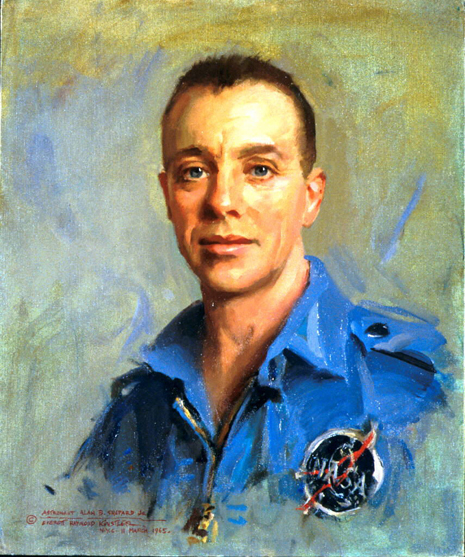American in Space: Alan Shepard’s Memorable Moments
This blog post originally appeared April 4, 2012
Note: On April 17, 2012, the Smithsonian’s Steven F. Udvar-Hazy Center of the National Air and Space Museum will become host to the Space Shuttle Discovery in a monumental event. Discovery will be flown from Cape Canaveral on the back of a Boeing 747 and will arrive later in the day at the Udvar-Hazy Center to become a permanent part of its collection.
As part of the Smithsonian-wide effort to share this special event with the world, this is the first of three articles featuring a discussion of some of the great personalities and moments of the National Aeronautics and Space Administration (NASA).

When the cosmonaut Yuri Gagarin went into space on April 12, 1961, the United States was preparing to answer the challenge. In the course of the next decade, the United States would take the galactic gauntlet thrown down by the Soviets and repeatedly raise the stakes. And ultimately, although the USSR had gotten out of the gate first, it was the Mercury 7 astronauts—Captain Virgil Grissom, U.S. Air Force; Lieutenant M. Scott Carpenter, U.S. Navy; Captain Gordon Cooper Jr., U.S. Air Force; Lieutenant Colonel John Glenn Jr., U.S. Marine Corps; Lieutenant Commander Walter Schirra Jr., U.S. Navy; Lieutenant Commander Alan Shepard Jr., U.S. Navy; Captain Donald Kent (“Deke”) Slayton, U.S. Air Force—who piloted the United States into the stars. They achieved fame not only for their courage, but also for the regularity with which they suited up for missions.
Less than one month after Gagarin’s flight, on May 5, 1961, Alan Shepard rode the Mercury capsule Freedom 7 into space history. Freedom 7 rode atop a Redstone rocket booster that propelled Shepard into a suborbital trajectory, making him the first American in outer space. Shepard was in the air for fifteen minutes, completing an arc that took him more than one hundred miles high and three hundred miles over the Atlantic, away from Cape Canaveral. Shepard became an instant hero. Although he was forced to sit out the rest of the decade due to an inner ear disease, the Mercury mission would not be his last trip into outer space.
Shepard’s second trek into space took place from January 31 through February 9, 1971. This Apollo 14 mission yielded one of the most unforgettable —if not wackiest—moments in NASA history. Apollo 14 was the third manned vehicle to land on the moon. Alan Shepard was mission commander, with Edgar D. Mitchell and Stuart Roosa acting as lunar module pilot and command module pilot, respectively. Shepard and Mitchell were tasked with undertaking various studies after landing on the lunar surface.
During their nine hours plus of extra-vehicular activity, Shepard produced a modified six-iron and two golf balls. After playing in the dust for a couple of moments, the mission commander spanked both balls out of camera view, saying they flew “miles and miles and miles.” In all probability, they only traveled a few hundred yards, but the image of the astronaut with the golf club on the moon is forever burned into the highlight reels of space travel.
Shepard, who was the face behind two of America’s most memorable moments beyond our planet, retired as a rear admiral in 1974; he died in 1998.
—Warren Perry, Catalog of American Portraits, National Portrait Gallery
Alan Shepard hitting golf balls on the moon.